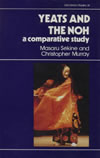
BL. W. B. Yeats
 |
250. Sekine, Masaru, Christopher Murray, and Augustine Martin. Yeats and the Noh: A Comparative Study. Gerrards Cross: Smythe, 1990.
Supplements but does not supersede Taylor (180). The central section of the work grows from Sekine’s assertions that three of Yeats’s ‘Plays for Dancers’ are ‘based on’ particular works from the nô, At the Hawk’s Well (12) on Yôrô (BK75), The Only Jealousy of Emer (14b) on Aoi no Ue (BK22), The Dreaming of the Bones (14a) on Nishikigi (BK8), and that the fourth, Calvary (17a), while not derived from a particular play, has similarities both to Sumidagawa (see D23) and Miwa. What follows is a mechanical series of comparisons between each play and its supposed progenitor, in terms of ‘theme’, then, in order, ‘characterization’, plot and function of musicians, ‘concepts of masks’, stage props, costumes, dancing, acting style, and poetry and imagery. Ultimately Sekine focuses more on what Yeats’s did not understand of the nô than what he did, and so argues, for example, that though Yeats ‘imitated the Noh form with a great deal of sincerity . . . he necessarily failed to make authentic Noh plays’ (see Chiba at a below for comment). Plays written after the plays for dancers are discussed only in passing, presumably because ‘they represent a pragmatic abandonment of the Japanese model’. Includes as introductory and appending essays other brief statements about ‘Yeats’s Noh’ (Augustine Martin), Yokomichi Mario’s Takahime (Sekine and Murray), ‘Acting in The Dreaming of the Bones’ (Colleen Hanrahan), the music for Yeats’s dance plays (Peter Davidson), and the relation between Yeats, Beckett, and the nô (Katharine Worth; see also A39, and BL190 and 235).
a. Reviews: Jacqueline Genet (Etudes irlandaises 15/2 [1990]: 242-44), Andrew Parkin (Canadian Journal of Irish Studies 18 [1992]: 227-29), and Dave Williams (Notes and Queries OS 236 / NS 38 [1991]: 408-09), despite quibbles, find the work valuable. Genet believes it ‘indispensable to all who are interested in Yeats’s drama’, Parkin that it will be ‘central to further discussion of Yeats and Noh’, and Williams that it is a ‘useful supplement to Taylor’s more theoretical writings on the same topic’ (especially 180). Yoko Chiba (Yeats Annual 10 [1993]: 298-301) disagrees: she cites examples of Sekine’s repetitions, ‘fragmentary’ tendencies, ‘confusing . . . comments’, and errors of fact and interpretation, and suggests that when Japanese commentators such as Ishibashi (see 131) and Sekine can free themselves of the idea that Yeats’s adaptations of nô are based on a ‘misunderstanding’ of the form, ‘our [own] understanding of Yeats’s relationship to Noh can become more creative and appreciative’.

